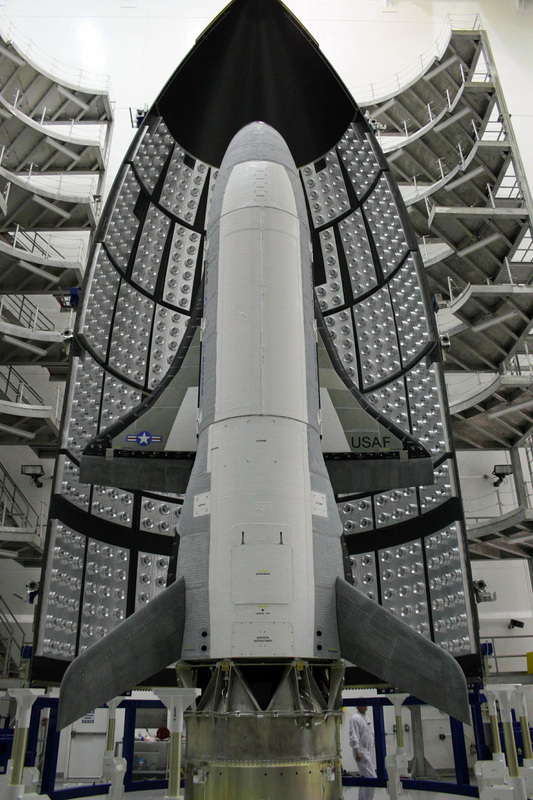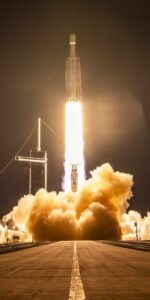
SpaceX is pushing earnestly towards its vaunted goal of up to a hundred launches in 2023, with no let-up in activity as the year’s final days ebb away. Following the loss of fleet-leader B1058 earlier this week, no less than three missions—two “single-stick” Falcon 9s from Cape Canaveral Space Force Station, Fla., and Vandenberg Space Force Base, Calif., and a triple-barreled Falcon Heavy from the Space Coast’s Kennedy Space Center (KSC)—are set to fly over three days between Thursday and New Year’s Eve, potentially closing out December as SpaceX’s first ten-flight month and ending 2023 on 97 orbital launches.

The loss of B1058, which launched NASA astronauts Doug Hurley and Bob Behnken aboard Dragon Endeavour on their historic Demo-2 mission to the International Space Station (ISS) on 30 May 2020, is intensely disappointing as it was the singular booster which returned U.S. astronauts to space, aboard a U.S. spacecraft, and from U.S. soil, since the end of the Space Shuttle Program in July 2011. It went on to become the most-flown member of SpaceX’s operational Falcon 9 fleet, its recent 19th launch setting it at least two missions ahead of any of its siblings.
Ironically, B1058’s fate was sealed not by any act of its own doing, for it successfully landed atop the Autonomous Spaceport Drone Ship (ASDS), “Just Read the Instructions”, only to topple partially overboard due to high waves and winds during transit back to Port Canaveral. According to various sources, the old booster was less than a hundred miles (160 kilometers) from port when the incident occurred and photographs revealed the wreckage of B1058’s lower fuselage—and buckled landing legs—still on their side on JRTI’s deck, with the upper part, which bore the iconic NASA “worm” logo, lost to the sea.

Despite suffering its first outright loss of a booster in almost three years, SpaceX can look back on 2023 with great pride, for the last dozen months have seen a 30-percent increase in mission cadence above 2022’s record-breaking haul of 61 launches. Last weekend’s demise of B1058 marked the 90th Falcon 9 flight of the year and, when coupled with a record-setting four Falcon Heavy launches in January, April, July and October, pushes the current tally of orbital missions to 94.
That list includes more than 60 Starlink flights in support of SpaceX’s ever-growing constellation of low-orbiting internet satellites, ten commercial geostationary communications satellites, three multi-payload Transporter “stacks”, two flights of the Tranche 0 Transport and Tracking Layer (TTL) for the Space Development Agency (SDA) and Europe’s Euclid deep-space observatory. Additionally, the Hawthorne, Calif.-headquartered organization launched three Crew Dragon and three Cargo Dragon missions to the ISS between March and last month.

Records have fallen like ninepins, with only four hours and 12 minutes elapsing between a pair of launches last spring. And SpaceX achieved its first eight-launch month in March, its first nine-launch month in August and looks set to wrap up its first-ever ten-launch month inside the next 72 hours.
First out of the starting gate will be a long-delayed Falcon Heavy, which is targeting liftoff from KSC’s historic Pad 39A at 8:07 p.m. EST Thursday, with a backup opportunity at 8:06 p.m. EST Friday. Flying tonight’s mission is the brand-new B1084 center core—set to be expended due to the high-energy requirements of its primary payload—and a pair of veteran side-boosters, B1064 and B1065, both of which supported four previous Heavy flights between November 2022 and last October.

Following liftoff, the center core and side-boosters will deliver the U.S. Space Force’s highly classified USSF-52 payload uphill under an impressive 5.4 million pounds (3.4 million kilograms) of thrust. The B1064 and B1065 side-boosters will be discarded a little over 2.5 minutes into ascent, returning to synchronized touchdowns on Landing Zones (LZ)-1 and 2 at Cape Canaveral, with B1084 discarded a minute or so later.
Weather conditions for tonight’s launch hover around 80-percent-favorable, with a risk of violating the Cumulus Cloud Rule, but Friday’s backup opportunity pledges 95-percent odds, tempered only by a slight chance of falling foul of Liftoff Winds. “An area of low pressure off the coast of the Carolinas will slowly move northeast through the day as a weak wave located in the Gulf of Mexico will move eastward across the central and southern portions of the state, bringing some spotty showers overnight and into Thursday morning,” noted the 45th Weather Squadron at Patrick Space Force Base.

“Much of the upper-level moisture associated with the wave will move off the coast by midday, leaving only low-topped showers along the front to the west by the launch window,” it was added. “Therefore, the primary launch weather concern is the Cumulus Cloud Rule associated with any showers that may development ahead and along the front.”
The USSF-52 mission bears the Space Force’s highly classified X-37B mini-shuttle, the seventh voyage by the two-vehicle fleet. This particular spacecraft will be flying for its fourth time, having already logged more than 1,966 cumulative days off the planet during its three prior missions: it spent 15 months in space between March 2011 and June 2012 and logged a pair of two-year orbital stays between May 2015 and May 2017 and more recently between September 2017 and October 2019.

It became the first X-37B to land on KSC’s former Shuttle Landing Facility (SLF) in May 2017 and was the first in the fleet to ride a Falcon 9 to orbit in September 2017. And although the bulk of its payloads remain shrouded in secrecy, X-37B missions evaluated Aerojet Rocketdyne’s XR-5A Hall-effect thruster in furtherance of the Advanced Extremely High Frequency (AEHF) satellite constellation and supported the Advanced Structurally Embedded Thermal Spreader-II (ASETS-II), which measured the performance of an oscillating heat pipe, and served as a testbed for a range of NASA experiments focused on the performance of materials in space.
Launch services contracts worth $130 million for the mission, under its original, pre-Space Force guise as Air Force Space Command (AFSPC)-52, were awarded to SpaceX by the Air Force in June 2018. This was bilaterally modified by $19.2 million in August 2021, raising the total face-value contract to $149.2 million.

Meanwhile, the launch moved from an initial placeholder in fall 2020 to April 2022, a date which itself rapidly moved further to the right. Rescheduled to fly earlier in December, the snakebitten mission found itself pushed back in response to an unfavorable weather picture for launch and recovery operations and ground-side technical issues pertaining to the USSF-52 payload.
Less than three hours after USSF-52, attention will turn to neighboring Space Launch Complex (SLC)-40 and a single-stick Falcon 9 booster set for its 12th mission with a 23-strong stack of Starlink satellites. The B1069 core—which was almost lost at the end of its maiden voyage two years ago—closes out 2023 with a record-tying eight launches, most recently just last month.

B1069 entered the fleet in December 2021, delivering the CRS-24 Cargo Dragon on the first leg of its month-long trek to the ISS. But she was almost lost seconds after touchdown, when she came within a hair’s breadth of missing the deck of the drone ship and toppling into the ocean.
The incident necessitated substantial repairs—including a brand-new suite of Merlin 1D+ first-stage engines—before B1069 re-entered service to log three missions in the second half of last year: emplacing 54 Starlinks to orbit in August, Eutelsat’s Hotbird 13F geostationary communications satellite in October and 40 broadband satellites in December for London, England-based OneWeb.

So far in 2023, she has lifted six Starlink batches to low-Earth orbit, as well as the dual-stacked SES-18 and SES-19 geostationary satellites for Luxembourg-based provider SES, back in March. Her March flight also formed part of a new SpaceX record of launching a pair of Falcon 9s within four hours and 12 minutes of each other.
It is therefore fitting that if B1069 launches on time tonight, only two hours and 54 minutes after the Falcon Heavy and USSF-52, she will close out 2023 with a new SpaceX record for the shortest interval between pairs of orbital-class missions. Weather conditions for late Thursday are broadly similar to the forecast for USSF-52, although slightly more optimistic with 90-percent favorability during B1069’s expansive launch “window” from 11:01 p.m. EST Thursday through 2:59 a.m. EST Friday.

Sixty-five minutes after launch, the 23-strong Starlink stack, totaling 40,600 pounds (18,400 kilograms), will be deployed into low-Earth orbit. The final SpaceX mission of 2023 is scheduled for Space Launch Complex (SLC)-4E at Vandenberg on Saturday, with a range of T-0 opportunities extending from 7:17 p.m. PST through 11:16 p.m. PST.
Flying the 97th and last Falcon-class mission of the year is newcomer B1082, which becomes the fifth brand-new single-stick booster to enter SpaceX’s fleet in 2023. Aboard are 21 Starlinks, totaling 37,000 pounds (16,800 kilograms), marking the 64th dedicated Starlink mission of the year and bringing to over 2,000 the total number of these flat-packed internet communications satellites emplaced into orbit so far since January.

As a network, Starlink facilitates high-speed and low-latency internet provision to 70 sovereign nations and international markets in North and South America, Europe, Asia, Oceania and Africa. Landlocked Eswatini—formerly Swaziland in southern Africa—and Paraguay joined Starlink earlier this month.
The Starlink “V2 Mini” satellites, first flown in February, boast three to four times greater “usable” bandwidth than earlier Starlink iterations. “V2 Minis include key technologies—such as more powerful phased-array antennas and the use of E-Band for backhaul—which will allow Starlink to provide 4x more capacity per satellite than earlier iterations,” SpaceX explained. “Among other enhancements, V2 Minis are equipped with new argon Hall thrusters for on-orbit maneuvering.”

Florida-based intercity operator Brightline adopted Starlink on its trains earlier in 2023, the first passenger rail service in the world to do so. Additionally, El Salvador’s Ministry of Education has begun integrating Starlink capability into its schools to help close the digital divide between urban and remote rural communities and 50 Rwandan schools are now connected via Starlink’s high-speed internet service.






6 Comments
Leave a Reply6 Pings & Trackbacks
Pingback:SpaceX Targets Tuesday for 2024’s First Launch, Busy January Lies Ahead - AmericaSpace
Pingback:SpaceX Targets Tuesday for 2024’s First Launch, Busy January Lies Ahead - SPACERFIT
Pingback:SpaceX Launches Transporter-10, Aims for Next Launch Under Two Hours Later - AmericaSpace
Pingback:SpaceX Launches Record-Setting Falcon Missions, Under Two Hours Apart - AmericaSpace
Pingback:SpaceX Launches Record-Setting Falcon Missions, Under Two Hours Apart - SPACERFIT
Pingback:SpaceX Targets Back-to-Back Falcon 9 Missions, Next Starship Launch - AmericaSpace